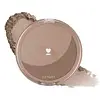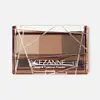What's inside
What's inside
 Key Ingredients
Key Ingredients

 Benefits
Benefits

 Concerns
Concerns

 Ingredients Side-by-side
Ingredients Side-by-side

Talc
AbrasivePolyethylene
AbrasiveNylon-12
Phenyl Trimethicone
Skin ConditioningCI 77492
Cosmetic ColorantSilica
AbrasiveMagnesium Myristate
CI 77499
Cosmetic ColorantCI 77491
Cosmetic ColorantCI 77891
Cosmetic ColorantDiisostearyl Malate
EmollientCaprylic/Capric Triglyceride
MaskingCaprylyl Glycol
EmollientEthylhexylglycerin
Skin ConditioningPolymethylsilsesquioxane
Methicone
EmollientDimethicone
EmollientTriethoxycaprylylsilane
Synthetic Fluorphlogopite
Tocopherol
AntioxidantTalc, Polyethylene, Nylon-12, Phenyl Trimethicone, CI 77492, Silica, Magnesium Myristate, CI 77499, CI 77491, CI 77891, Diisostearyl Malate, Caprylic/Capric Triglyceride, Caprylyl Glycol, Ethylhexylglycerin, Polymethylsilsesquioxane, Methicone, Dimethicone, Triethoxycaprylylsilane, Synthetic Fluorphlogopite, Tocopherol
Diisostearyl Malate
EmollientTriethylhexanoin
MaskingZinc Myristate
Hdi/Trimethylol Hexyllactone Crosspolymer
Dimethicone
EmollientPentylene Glycol
Skin ConditioningPhenoxyethanol
PreservativeSilica
AbrasiveMethylparaben
PreservativeTocopherol
AntioxidantWater
Skin ConditioningButylene Glycol
HumectantHydroxyapatite
AbrasiveCyclopentasiloxane
EmollientZinc Oxide
Cosmetic ColorantTrimethylsiloxysilicate
EmollientAlcohol Denat.
AntimicrobialSodium Lauroyl Glutamate
Palmaria Palmata Extract
Skin ProtectingPanax Ginseng Root Extract
EmollientPolyquaternium-61
Skin ConditioningHydrolyzed Collagen
EmollientCysteine/Oligomeric Proanthocyanidin
Skin ConditioningPvp
Emulsion StabilisingHydroxyethylcellulose
Emulsion StabilisingAlgin
MaskingCitrus Junos Fruit Extract
Skin ConditioningChitosan
Cetearyl Glucoside
EmulsifyingSodium Polyglutamate
HumectantSodium Hyaluronate
HumectantTalc
AbrasiveMica
Cosmetic ColorantCI 77492
Cosmetic ColorantTitanium Dioxide
Cosmetic ColorantDiisostearyl Malate, Triethylhexanoin, Zinc Myristate, Hdi/Trimethylol Hexyllactone Crosspolymer, Dimethicone, Pentylene Glycol, Phenoxyethanol, Silica, Methylparaben, Tocopherol, Water, Butylene Glycol, Hydroxyapatite, Cyclopentasiloxane, Zinc Oxide, Trimethylsiloxysilicate, Alcohol Denat., Sodium Lauroyl Glutamate, Palmaria Palmata Extract, Panax Ginseng Root Extract, Polyquaternium-61, Hydrolyzed Collagen, Cysteine/Oligomeric Proanthocyanidin, Pvp, Hydroxyethylcellulose, Algin, Citrus Junos Fruit Extract, Chitosan, Cetearyl Glucoside, Sodium Polyglutamate, Sodium Hyaluronate, Talc, Mica, CI 77492, Titanium Dioxide
Ingredients Explained
These ingredients are found in both products.
Ingredients higher up in an ingredient list are typically present in a larger amount.
Ci 77492 is also hydrated iron III oxide. It's sole purpose is to give a yellow hue to products.
Iron III oxides are classified as inorganic chemicals for coloring.
Synthetically created Ci 77492 is considered safer than those naturally found. This is because the synthetically created version may contain less impurities. Iron oxides are generally non-toxic and non-allergenic.
Learn more about CI 77492Diisostearyl Malate is an emollient and most often used in lip products. It comes from isostearyl alcohol, a fatty acid, and malic acid, an AHA.
As an emollient, Diisostearyl Malate helps create a thin film on your skin to trap moisture in. This helps keep your skin soft and smooth.
Dimethicone is a type of synthetic silicone created from natural materials such as quartz.
What it does:
Dimethicone comes in different viscosities:
Depending on the viscosity, dimethicone has different properties.
Ingredients lists don't always show which type is used, so we recommend reaching out to the brand if you have questions about the viscosity.
This ingredient is unlikely to cause irritation because it does not get absorbed into skin. However, people with silicone allergies should be careful about using this ingredient.
Note: Dimethicone may contribute to pilling. This is because it is not oil or water soluble, so pilling may occur when layered with products. When mixed with heavy oils in a formula, the outcome is also quite greasy.
Learn more about DimethiconeSilica, also known as silicon dioxide, is a naturally occurring mineral. It is used as a fine, spherical, and porous powder in cosmetics.
Though it has exfoliant properties, the function of silica varies depending on the product.
The unique structure of silica enhances the spreadability and adds smoothness, making it a great texture enhancer.
It is also used as an active carrier, emulsifier, and mattifier due to its ability to absorb excess oil.
In some products, tiny microneedles called spicules are made from silica or hydrolyzed sponge. When you rub them in, they lightly polish away dead skin layers and enhance the penetration of active ingredients.
Learn more about SilicaTalc is a clay mineral. It helps absorb moisture and improve the texture of products. Like other types of clay, Talc can have a slight exfoliating effect on skin. Talc can be added to increase the volume of products.
Some Baby powders are made by combining talc with corn starch. The word "talc" comes from Latin and originates from Arabic. Talc is a mineral commonly found throughout the world.
If you have any concerns about using talc, we recommend checking out the FDA's official page.
Learn more about TalcTocopherol (also known as Vitamin E) is a common antioxidant used to help protect the skin from free-radicals and strengthen the skin barrier. It's also fat soluble - this means our skin is great at absorbing it.
Vitamin E also helps keep your natural skin lipids healthy. Your lipid skin barrier naturally consists of lipids, ceramides, and fatty acids. Vitamin E offers extra protection for your skin’s lipid barrier, keeping your skin healthy and nourished.
Another benefit is a bit of UV protection. Vitamin E helps reduce the damage caused by UVB rays. (It should not replace your sunscreen). Combining it with Vitamin C can decrease sunburned cells and hyperpigmentation after UV exposure.
You might have noticed Vitamin E + C often paired together. This is because it is great at stabilizing Vitamin C. Using the two together helps increase the effectiveness of both ingredients.
There are often claims that Vitamin E can reduce/prevent scarring, but these claims haven't been confirmed by scientific research.
Learn more about Tocopherol